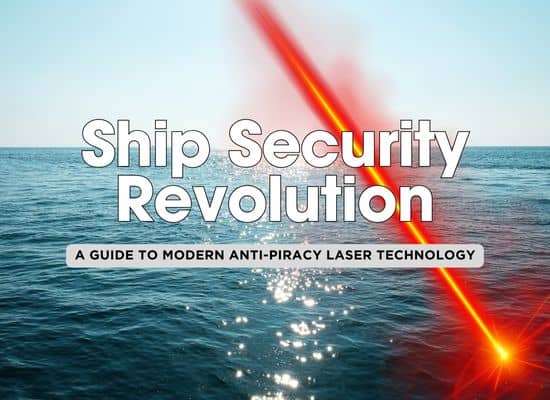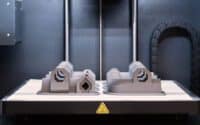Laser Gun Defense: Top 10 Questions Every Shipowner Needs Answered Before Investing

Piracy remains a persistent threat, but laser gun defense systems are changing the game. These cutting-edge, non-lethal solutions promise enhanced security, but are they right for your ship? Before investing, here are the top 10 questions every shipowner needs answered.
Disclaimer: The following information is provided for general guidance and informational purposes only. Readers should consult relevant maritime laws, regulations, and professionals before making decisions related to laser gun defense systems.
- How Effective Are Laser Guns for Anti-Piracy?
- What Are the Legal Implications of Using Laser Weapons?
- How Do Laser Guns Compare to Other Anti-Piracy Measures?
- What Is the Cost of Acquiring, Installing, and Maintaining Laser Guns?
- Are Laser Guns Non-Lethal or Potentially Dangerous?
- What Are the Environmental and Operational Limitations?
- How User-Friendly Are These Systems?
- How Durable Are Laser Systems in Marine Environments?
- What Companies Are Leading in Maritime Laser Technology?
- What Is the Return on Investment (ROI) for Laser Systems?
1️⃣ How Effective Are Laser Guns for Anti-Piracy?
Laser guns are an innovative, non-lethal solution designed to prevent piracy. They work by emitting intense beams of light to disorient attackers, impairing their vision and ability to aim or navigate. While highly effective in close- to mid-range scenarios, their performance can vary depending on environmental conditions and system quality.
Key Effectiveness Insights:
- Range: Most maritime laser systems are effective at ranges of up to 500–1,000 meters.
- Deterrence: The dazzling effects make it nearly impossible for attackers to maintain focus, providing enough time for the vessel to evade or call for assistance.
- Limitations: They are less effective in fog, rain, or direct sunlight.
| ShipUniverse: Laser Gun Effectiveness Overview | ||
| Feature | Details | Practical Use |
| Range | 500–1,000 meters | Ideal for disorienting attackers before they get too close. |
| Deterrence Capability | Blinds attackers, making it hard to aim or board. | Highly effective in deterring small, fast pirate boats. |
| Limitations | Reduced effectiveness in adverse weather conditions. | Best used in conjunction with other defensive measures. |
2️⃣ What Are the Legal Implications of Using Laser Weapons?
Laser defense systems are innovative, but their legality depends on where and how they are deployed. Shipowners must navigate international maritime laws, regional regulations, and liability concerns to ensure compliance.
Key Legal Considerations:
- International Waters:
- The use of laser weapons is generally allowed for self-defense, but they must not cause permanent harm.
- The United Nations Convention on the Law of the Sea (UNCLOS) permits self-defense but emphasizes proportionality and non-lethality.
- Port State Regulations:
- Some countries may restrict the use or even possession of laser systems in their territorial waters.
- Always check port state laws before entering.
- Crew Training and Accountability:
- Operators must be trained to avoid unintended harm.
- Misuse could lead to liability for injuries or damage to other vessels.
| ShipUniverse: Legal Implications of Laser Weapons | ||
| Aspect | Details | Practical Advice |
| International Waters | Permitted under UNCLOS for self-defense; must be non-lethal. | Use only to disorient attackers, not to cause harm. |
| Port State Laws | Varies by country; some restrict or ban laser weapons. | Research and comply with local laws before port entry. |
| Liability | Improper use could result in legal claims. | Ensure operators are trained and follow strict guidelines. |
3️⃣ How Do Laser Guns Compare to Other Anti-Piracy Measures?
Laser guns are one of many tools available to shipowners for anti-piracy defense. Comparing them to alternatives like water cannons, acoustic devices, and armed guards highlights their unique strengths and limitations.
Key Comparisons:
- Non-Lethality:
- Laser guns are non-lethal, making them suitable for ships operating in areas with strict weapon restrictions.
- Unlike armed guards, they minimize risks of escalating conflicts.
- Range and Precision:
- Lasers are effective at disorienting attackers at longer ranges than water cannons but may not be as versatile in harsh conditions.
- Cost-Effectiveness:
- Laser systems are a one-time investment with minimal ongoing costs, unlike armed guards, who require salaries and accommodations.
| ShipUniverse: Comparing Anti-Piracy Measures | |||
| Measure | Strengths | Limitations | Cost |
| Laser Guns | Non-lethal, long-range, precise. | Less effective in adverse weather. | High upfront; minimal ongoing. |
| Water Cannons | Effective for close-range defense. | Limited range; requires manual operation. | Moderate upfront and maintenance. |
| Acoustic Devices | Long-range, non-lethal, crowd control. | Can affect crew if misused. | Moderate upfront and training costs. |
| Armed Guards | Deterrent, effective in direct combat. | High costs; potential for escalation. | Recurring salaries, logistics. |
4️⃣ What Is the Cost of Acquiring, Installing, and Maintaining Laser Guns?
Laser gun systems for maritime defense represent a significant upfront investment, but they can prove cost-effective over time due to minimal ongoing expenses. Understanding these costs is crucial for shipowners evaluating their budgets.
Key Cost Components:
- Acquisition Costs:
- Basic systems start at $25,000, while advanced systems with enhanced range and automation can exceed $250,000.
- Installation Costs:
- Depending on the ship's size and power systems, installation costs range from $5,000 to $50,000.
- Additional costs may arise for integrating the system with existing security infrastructure.
- Maintenance and Upkeep:
- Routine maintenance is relatively low, often under $5,000 per year.
- Systems may require software updates and occasional hardware repairs.
| ShipUniverse: Laser Gun Cost Breakdown | ||
| Cost Component | Details | Estimated Expense |
| Acquisition | Basic to advanced systems with varying features. | $50,000–$250,000+ |
| Installation | Depends on ship size, power systems, and integration needs. | $10,000–$50,000 |
| Maintenance | Annual upkeep, software updates, and occasional repairs. | $2,000–$5,000/year |
5️⃣ Are Laser Guns Non-Lethal or Potentially Dangerous?
Laser guns are designed as non-lethal deterrent systems, making them a safer option for maritime defense. However, improper use or lack of safeguards could lead to unintended consequences.
Key Points About Safety:
- Non-Lethal Design:
- Most maritime laser systems aim to disorient attackers temporarily by impairing vision without causing permanent damage.
- They do not emit enough energy to physically harm people or structures.
- Potential Risks:
- Prolonged exposure to high-intensity beams can result in eye injuries or temporary blindness.
- Misalignment or operator error could pose risks to crew members or other nearby vessels.
- Safety Features:
- Modern systems include beam intensity controls and targeting precision to minimize accidental harm.
- Automated shutdown mechanisms prevent overuse or misdirection.
| ShipUniverse: Safety Aspects of Laser Guns | ||
| Aspect | Details | Practical Advice |
| Non-Lethality | Designed to disorient attackers without causing harm. | Ensure systems comply with non-lethal regulations. |
| Potential Risks | Eye injuries or temporary blindness with prolonged exposure. | Train operators to use precise targeting techniques. |
| Safety Features | Beam intensity controls and automated shutdown mechanisms. | Invest in systems with robust safety certifications. |
6️⃣ What Are the Environmental and Operational Limitations?
Laser gun systems, while effective, are not without their environmental and operational constraints. Understanding these limitations is key to maximizing their performance in real-world conditions.
Key Environmental and Operational Challenges:
- Weather Conditions:
- Laser effectiveness is reduced in fog, rain, and heavy seas due to beam dispersion.
- Bright sunlight can diminish the intensity and visibility of the beam.
- Power Requirements:
- Lasers require consistent power, which could strain smaller vessels' power systems.
- Battery backups or integration with the ship’s energy management system are often necessary.
- Range and Accuracy:
- Effective range varies but is generally 500–1,000 meters.
- Precise targeting becomes more challenging with increased distance or in rough sea states.
| ShipUniverse: Environmental and Operational Limitations of Laser Guns | ||
| Challenge | Details | Mitigation Strategies |
| Weather Conditions | Fog, rain, and bright sunlight reduce beam effectiveness. | Use in tandem with other defense measures during adverse weather. |
| Power Requirements | Requires a steady power source, which may strain smaller ships. | Install dedicated power supplies or battery backups. |
| Range and Accuracy | Effective range is 500–1,000 meters; accuracy drops in rough seas. | Operate within optimal range and ensure trained operators. |
7️⃣ How User-Friendly Are These Systems?
Laser gun systems are designed for ease of use, but their effectiveness often depends on proper training and integration into a ship’s security operations. Modern systems emphasize automation and intuitive controls to reduce operator error.
Key Points on Usability:
- Ease of Operation:
- Many systems feature simple point-and-shoot interfaces or joystick controls.
- Advanced systems include automated targeting and tracking to reduce the need for manual intervention.
- Training Requirements:
- Basic training is necessary for safe and effective use.
- Training sessions typically last a few days and cover operation, safety protocols, and maintenance.
- Remote and Automated Controls:
- Some systems can be operated remotely from the ship’s bridge, enhancing safety during attacks.
- Automation allows the system to detect and target threats autonomously, minimizing operator workload.
| ShipUniverse: Usability of Laser Gun Systems | ||
| Feature | Details | Practical Benefits |
| Ease of Operation | Intuitive controls with point-and-shoot interfaces. | Minimal learning curve for crew members. |
| Training Requirements | Short training sessions covering operation and safety. | Ensures proper use and reduces the risk of accidents. |
| Remote Control | Systems can be operated from the bridge or control room. | Improves safety and reduces exposure during attacks. |
| Automation | Automated targeting and threat detection features. | Reduces operator workload and increases efficiency. |
8️⃣ How Durable Are Laser Systems in Marine Environments?
Durability is a key consideration for laser gun systems, as they must withstand the harsh conditions of the marine environment, including saltwater exposure, extreme temperatures, and constant motion.
Key Points on Durability:
- Corrosion Resistance:
- Laser systems are typically built with corrosion-resistant materials like stainless steel or treated aluminum to withstand saltwater.
- Protective casings and sealing help prevent water intrusion.
- Shock and Vibration Tolerance:
- Systems are designed to handle vibrations from engines and rough seas.
- Mounting systems often include shock-absorbing components.
- Operational Lifespan:
- High-quality systems can last 10–15 years with proper maintenance.
- Regular inspections and preventative maintenance are essential to ensure longevity.
| ShipUniverse: Durability of Laser Gun Systems | ||
| Aspect | Details | Practical Advice |
| Corrosion Resistance | Built with stainless steel or treated aluminum to prevent rust. | Ensure the system is certified for marine use. |
| Shock and Vibration Tolerance | Designed to withstand vibrations and rough seas. | Use proper mounting systems to reduce wear. |
| Operational Lifespan | 10–15 years with regular maintenance and inspections. | Schedule routine checks to extend system life. |
9️⃣ What Companies Are Leading in Maritime Laser Technology?
Several companies are at the forefront of developing laser defense systems for maritime use, offering advanced technology tailored to the unique challenges of the marine environment. Choosing a reputable manufacturer ensures better performance, support, and reliability.
Key Players in Maritime Laser Technology:
- Raytheon Technologies
- Known for cutting-edge laser systems adapted from military applications.
- Offers high-intensity lasers with automated targeting and tracking.
- BAE Systems
- Provides advanced, non-lethal laser deterrent solutions.
- Focuses on integrating laser systems into broader maritime defense frameworks.
- Boeing
- Specializes in laser technologies for large vessels and military-grade applications.
- Known for scalability and integration with existing ship systems.
- LaserMax Defense
- Offers compact, versatile laser systems for smaller commercial vessels.
- Focused on non-lethal, cost-effective solutions for anti-piracy.
- Lockheed Martin
- Develops powerful laser systems capable of long-range deterrence.
- Provides extensive training and support for maritime customers.
| ShipUniverse: Leading Companies in Maritime Laser Technology | ||
| Company | Specialization | Notable Features |
| Raytheon Technologies | Military-grade laser systems for maritime use. | Automated targeting, high-intensity beams. |
| BAE Systems | Integrated non-lethal laser deterrents. | Scalable solutions for large vessels. |
| Boeing | Laser systems for large and military-grade vessels. | Focus on system scalability and integration. |
| LaserMax Defense | Compact, versatile lasers for smaller ships. | Cost-effective and easy to install. |
| Lockheed Martin | Long-range, high-power laser systems. | Comprehensive training and support packages. |
🔟 What Is the Return on Investment (ROI) for Laser Systems?
Investing in laser gun defense systems can offer significant long-term benefits, but understanding the ROI helps shipowners weigh the costs against the advantages. While laser systems have a high upfront cost, they can reduce expenses and risks over time.
Key Factors Influencing ROI:
- Reduction in Piracy-Related Losses:
- Preventing boarding saves cargo, vessel integrity, and crew safety.
- Avoids ransom payments and operational delays.
- Lower Insurance Premiums:
- Some insurers offer discounts for vessels equipped with advanced defense systems.
- Minimal Ongoing Costs:
- Unlike armed guards or other measures, lasers have minimal maintenance expenses.
- Improved Operational Efficiency:
- Laser systems allow ships to navigate high-risk areas without needing additional escorts or rerouting.
| ShipUniverse: ROI Analysis for Laser Gun Systems | ||
| Factor | Details | Impact on ROI |
| Piracy Prevention | Avoid cargo loss, ransom payments, and operational delays. | High – significant savings in high-risk areas. |
| Insurance Savings | Potential discounts from insurers for enhanced security. | Moderate – depends on insurer policies. |
| Maintenance Costs | Low annual maintenance compared to other measures. | High – reduces long-term operational costs. |
| Operational Flexibility | Enables safe navigation in high-risk areas without escorts. | High – reduces delays and rerouting costs. |
Insider Tips
1️⃣ 🛠 Maintenance is Key:
Regularly inspect your laser system for signs of wear and tear. Saltwater exposure can be tough on equipment, so schedule routine checks to avoid downtime.
2️⃣ 📚 Train Your Crew Well:
Invest in proper training for operators. A well-trained crew can maximize the system's effectiveness and minimize risks during emergencies.
3️⃣ 🌦 Be Weather-Wise:
Know when and where to rely on your laser systems. In foggy or rainy conditions, supplement lasers with other deterrents like water cannons or acoustic devices.
4️⃣ ⚡ Power Up:
Ensure your ship’s power systems are sufficient to handle the laser’s energy needs. Consider backup batteries or power integration to avoid disruptions.
5️⃣ 💡 Combine Defenses:
No single system is foolproof. Use laser guns as part of a layered security approach with additional measures like reinforced perimeters, surveillance, and tracking systems.
6️⃣ 🌍 Research Port Laws:
Check the legality of laser systems in ports along your route. Some countries may restrict their use or require special permissions.
7️⃣ 📈 Leverage Insurance Benefits:
Inform your insurer about the installation of laser systems. Many providers offer lower premiums for enhanced security measures.
8️⃣ 🚨 Test Regularly:
Perform regular drills to test the system’s functionality and crew readiness. Simulations can ensure your team is prepared for real-life scenarios.
9️⃣ 🤝 Choose Reputable Vendors:
Partner with established manufacturers who offer reliable warranties and customer support. This ensures long-term performance and peace of mind.
🔟 📝 Document Everything:
Keep records of training, maintenance, and system performance. These can be useful for insurance claims and regulatory compliance.

Do you have a Maritime Product or Service that may be of interest to Shipowners? Tell us about it here!
Do you have feedback or insights? Please reach out to editor @ shipuniverse.com



